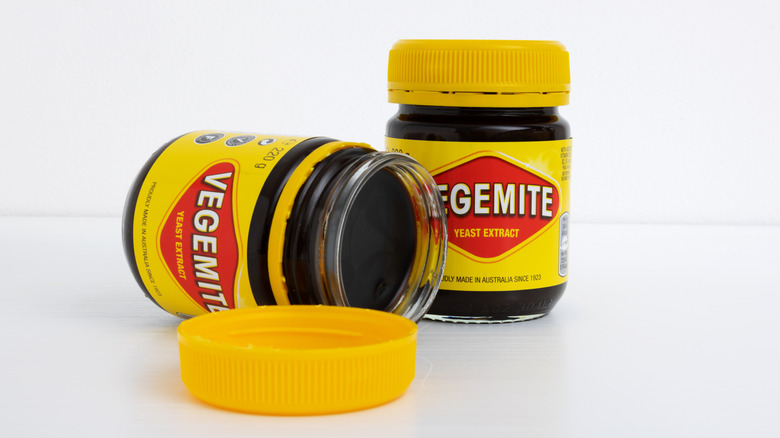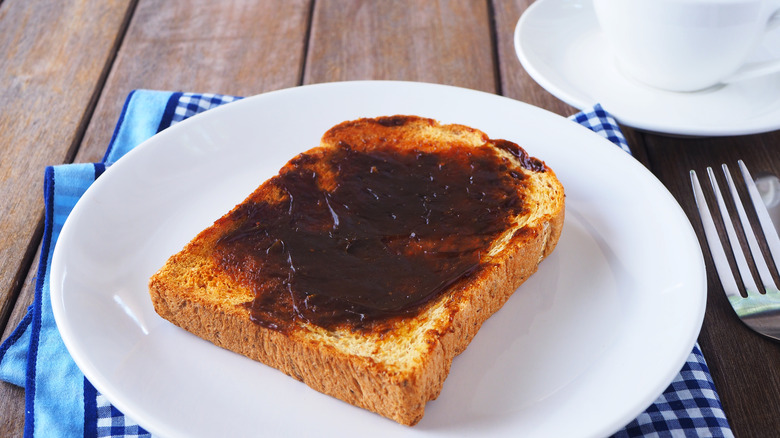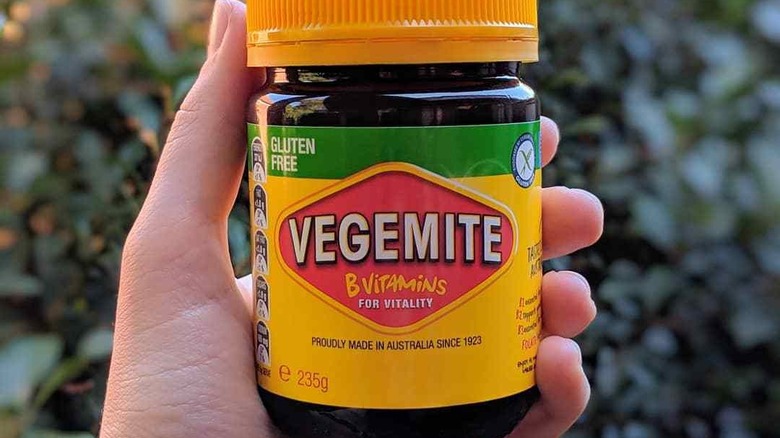What Is Vegemite And What Does It Taste Like?
We may receive a commission on purchases made from links.
The appeal of Vegemite can be hard to describe to the uninitiated. The Australian-based delicacy is beloved by many who grew up eating it. The idea of a concentrated yeast spread might not sound appealing to everyone, especially those in the U.S. who are unfamiliar with its unique taste or the flavor of its British counterpart, Marmite. While the rise in popularity of nutritional yeast as a umami-flavored condiment packed with B vitamins might help someone understand the benefits of a yeast spread, it doesn't quite prepare their taste buds for what to expect.
Vegemite is one of those irreplaceable, popular condiments with an ardent following in the similar vein of gochujang in Korea, lingonberry sauce in Sweden, harissa in North Africa, or Miracle Whip in the U.S. For devotees, these foods often speak to a sense of home and childhood. Sure, some might argue the salty spread is a departure from an aioli or ketchup. But when applied correctly, Vegemite is a taste people can't stay away from.
What is Vegemite?
Vegemite is a black paste sold in small jars. The simple but flavorful spread is made without artificial colors or flavors, and its ingredients include salt, vegetable extract, malt extract from barley, and complex B vitamins niacin, thiamine, riboflavin, and folate.
The BBC described the precursor to Vegemite as a "thick, bitter sludge" that began as a substitute (albeit, a poor one) when the British-made Marmite spread couldn't reach Australia during World War I. A chemist partnered with the Fred Walker Company and fine-tuned the replacement spread made from brewer's yeast, a natural leftover product from beer production. Vegemite first appeared in grocery stores across Australia in 1923 marketed as a pairing with Kraft processed cheese, of which the Fred Walker Company owned the exclusive the rights to sell in The Commonwealth. Vegemite gained popularity after the British Medical Association recommended the product as a source of vitamin B, so it was rationed during World War II in order to send to the troops. What's Cooking America claims that the spread is now such a cultural touch point many Australians travel with jars to always have it on hand.
Vegemite is considered an acquired taste even by the manufacturer, which recommends that it's "best acquired as a child" (via the The New York Times). In other words, it's an especially salty condiment that may be too aggressive for the typical American palate. Once hooked, however, devotees might eat the yeast extract straight from the jar.
How is Vegemite made?
Vegemite yeast spread is actually exactly what it sounds like. Similar to nutritional yeast flakes that can be sprinkled on popcorn or eggs, Vegemite is made from brewer's yeast, which, according to Mount Sinai, derives from saccharomyces cerevisiae, a one-celled fungus. While, no surprise, brewer's yeast is primarily used for beer production, it's become a popular nutritional supplement in recent years due to its high vitamin and mineral content.
MyRecipes explains that Vegemite was originally made from excess brewer's yeast that had been left unused as a result of brewing beer during World War I. The yeast was broken down into a clear extract, then mixed with some spices and vegetable extracts such as salt, celery, and onion. Dr. Cyril P Callister spent months in the laboratory testing how to develop a spread from brewer's yeast (via Vegemite). Callister created the spreadable paste that was labelled "Pure Vegetable Extract" before a contest was held in 1923 to name the spread Vegemite.
Vegemite vs. Marmite
Similar to the origin story of Vegemite, the development of Marmite occurred after a German scientist realized that leftover brewer's yeast from making beer could be concentrated and eaten (via Delish). The bold and strange move to eat the black paste paid off, resulting in a vitamin-rich recipe that is now a trade secret. Delish reports that Marmite's major ingredients are yeast extract with glutamic acid, salt, and extracts of vegetables, spices and celery. Similar to the B-vitamin rich Vegemite, Marmite is also full of vitamins and minerals such as magnesium, calcium, potassium, iron and selenium.
Since Vegemite was created to replace a shortage of the British Marmite spread, you might be asking what's the difference? After all, they're both dark, sticky yeast pastes. Look closer and Vegemite is jet black with a thicker texture closer to peanut butter. Marmite is a dark brown color with more of a honey-like consistency. Each also has a distinct flavor. While Culture Trip describes the salty intensity of both spreads, Vegemite provides more of a flavor punch compared to Marmite's hint of sweetness and richer, meatier flavor. Both spreads should be used sparingly when slathered on buttered toast, added to eggs, or for any of their other numerous applications.
What does Vegemite taste like?
Vegemite might be an institution in The Commonwealth, but many in the U.S. are unsure about what to expect from the spread. Despite it's chocolate-like appearance, the flavor isn't sweet like Nutella, another spreadable import. Here is how Australian musician Tyrone Lindqvist described the taste of Vegemite to FoodBeast: "You know soy sauce that you might have with rice, that adds kind of a salty flavor? I'd say Vegemite is just like that but people tend to over use it if they're just trying it for the first time." In essence, it's salty, bitter, and designed to be used in moderation. Lindqvist suggests the taste shifts depending on the pairing. The umami flavor finds balance with a thin spread of Vegemite on buttered toast, adding a few strips of cheese or a few slices of avocado.
Conspiracy brewed over the taste when the company decided to rebrand in 2019, when it was officially announced that the recipe was vegan. This led many fans to denounce the "new" flavor, per Delicious. The company declared, however, that the recipe hadn't changed — it's always been vegan. A spokesperson for Vegemite told the site that variations in the natural brewer's yeast is common but the ingredients have remained the same since 1922.
What does Vegemite smell like?
The smell of Vegemite is about as unique as the taste of the spread. So, is it true that the yeast spread doesn't smell like anything but itself? The Guardian reports that its distinctive "sort of meaty-but-not-meat-smell" was analyzed by scientist Renée Webster who compared the individual "aroma compounds" to a database of other chemicals that cause different food smells. The strongest aroma turns out to be Sulfurol, a "sulfur, meaty, chicken broth" smell that is likely to be the first smell and the most recognizable to Vegemite eaters.
Webster also found the chemical cis-9-hexadecenoic acid, which is known to be connected with "old-person smell" and might not be the first aroma one seeks when reaching for a condiment. A musty and stale odor also might sound familiar to both lovers of the spread and any detractors who could suddenly feel a bit more justified in their aversion to the paste.
How to eat Vegemite
Eating Vegemite requires a bit of preparation when trying the spread for the first time. Thinking of the condiment as an umami flavor similar to a soy sauce helps to inform how it should be used. Chowhound recommends adding the spread to popcorn, cheese scrolls, and even to your brownie recipe. Vegemite can also add flavor to a Bolognese or a stew. The Spruce suggests slathering a bit on toast with a soft-boiled egg, smeared with avocado, or added to a meat pie.
The classic recipe is with a little butter on warm toast. Aussie native Hugh Jackman explained on "The Tonight Show Starring Jimmy Fallon" how the morning ritual of spreading Vegemite on toast needs to be "refined." Fallon tried the umami spread but claimed the flavor seemed to be "missing something." Jackman says the toast needs be to white bread and butter should melt into the bread. He also warns the amount of Vegemite added should only be a small dollop, easily the biggest mistake many beginners make when trying the spread for the first time.
Where to buy Vegemite
Vegemite isn't a product that is carried in most grocery stores in the U.S. If a store has an imported food section, then you might be in luck. The Daily Meal recommends heading to World Market since it's known to carry jars of the spread in its 250 stores across the country. Shopping on Amazon is an easy option for many, but Delish advises to keep an eye out for scams from third-party sellers, particularly when it comes to upcharges and counterfeit items. You could also head to a British specialty shop and stock up on the close alternative Marmite in a pinch.
Slate reports that despite rumors of U.S. Customs banning the yeast spread due to its folate levels, this just isn't true. The B vitamin content in Vegemite is naturally occurring, so it's not under regulation from the Food and Drug Administration. Similar unfounded panic has reached Canada about bans on Marmite in recent years. Yeast spread lovers can rest easy that these products aren't disappearing anytime soon.
Is Vegemite Vegan?
Finding sources of complex B vitamins when eating a vegan diet is essential to staying healthy. (Vitamin B12, for example, is only found in animal proteins and other animal-based foods.) That's where Vegemite can come in. Vegemite is packed with B vitamins and suitable for vegans.
The Vegan Foundry recommends the spread for its lack of animal products, but the site's mention comes with a caveat. Vegemite lists Colour (E150d) as an ingredient, which the Vegan Foundry explains is an artificial color leading some vegans to stay away from the spread. Testing artificial colors on animals is also ongoing, not a one time experiment, the site notes, because dyes need to be studied for ongoing potential health risks. The issue of consuming artificial food dye is complicated for vegans and vegetarians because they are tested on animals like dogs and mice to ensure that they are safe for humans to eat.
Nutritional information about Vegemite
Vegemite has long been marketed as a healthy food for the whole family. As we mentioned earlier, the yeast spread is made from brewer's yeast, which is produced by a one-celled fungus called saccharomyces cerevisiae. Healthline found that Vegemite has the health benefits of B vitamins thiamine, riboflavin, niacin, and folate. The Mayo Clinic explains that folate is the naturally occurring form of vitamin B-9, and the synthetic form found in cereals and pasta is known as folic acid. Folate lowers the risk of high blood pressure and is helpful for pregnancy to prevent birth defects.
In one teaspoon, the spread contains only 11 calories and less than 1 gram of fat. Not bad! It also has 1.3 grams of protein. If you're concerned about the high salt content, seek out the reduced salt version of the spread that offers the same daily intake of vitamins only with less sodium.
Other varieties of Vegemite
Vegemite is now available in a range of styles. The original formula is served in a recognizable yellow jar. Vegemite Squeezy offers up the spread in a squeeze jar for anyone too busy to bother with a knife. For bagels, consider Vegemite Cheesybite which is a creamy cheese spread containing dairy, delivering the popular combination in one container. Vegemite 40% Less Salt is the smart option for anyone with health concerns or dietary restrictions when it comes to sodium intake.
Vegemite Gluten Free took two years to get right due to its "complex formulation," according to the company. Adjusting the original formula to accommodate those who follow a gluten-free diet wasn't a simple task. The original formula is based on brewer's yeast that is fed gluten. The gluten-free style is made with yeast that is only fed from sources without any traces of gluten, making it safe for celiac and low FODMAP diets. Vegemite developed the formula to appeal to more Australians after seeing one in four consumers avoid gluten in their diets.










